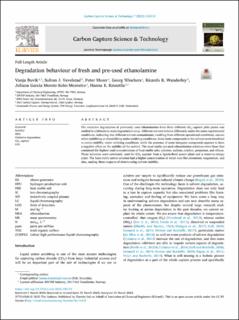| dc.contributor.author | Buvik, Vanja | |
| dc.contributor.author | Vevelstad, Solrun Johanne | |
| dc.contributor.author | Moser, Peter | |
| dc.contributor.author | Wiechers, Georg | |
| dc.contributor.author | Wanderley, Ricardo R. | |
| dc.contributor.author | Monteiro, Juliana | |
| dc.contributor.author | Knuutila, Hanna K | |
| dc.date.accessioned | 2023-10-30T08:52:32Z | |
| dc.date.available | 2023-10-30T08:52:32Z | |
| dc.date.created | 2023-05-16T13:42:25Z | |
| dc.date.issued | 2023 | |
| dc.identifier.citation | Carbon Capture Science & Technology (CCST). 2023, 7 100110-?. | en_US |
| dc.identifier.uri | https://hdl.handle.net/11250/3099321 | |
| dc.description.abstract | The oxidative degradation of previously used ethanolamine from three different CO2 capture pilot plants was studied in a laboratory-scale degradation setup. Different solvents behave differently under the same experimental conditions, indicating that different solvent contaminants, resulting from different operational conditions, can act either stabilising or destabilising under oxidising conditions. Some ionic compounds in the solvent seem beneficial to amine stability under oxidising conditions, while the presence of some inorganic compounds appears to have a negative effect on the stability of the solvent. The most stable pre-used ethanolamine solutions were those that contained the highest total concentrations of heat-stable salts, calcium, sodium, sulphur, potassium, and silicon. These solutions were previously used for CO2 capture from a lignite-fired power plant and a waste-to-energy plant. The least stable amine solution had a higher concentration of metal ions like chromium, magnesium, and zinc, making these suspects of deteriorating solvent stability. | en_US |
| dc.language.iso | eng | en_US |
| dc.publisher | Elsevier | en_US |
| dc.rights | Navngivelse 4.0 Internasjonal | * |
| dc.rights.uri | http://creativecommons.org/licenses/by/4.0/deed.no | * |
| dc.title | Degradation behaviour of fresh and pre-used ethanolamine | en_US |
| dc.title.alternative | Degradation behaviour of fresh and pre-used ethanolamine | en_US |
| dc.type | Peer reviewed | en_US |
| dc.type | Journal article | en_US |
| dc.description.version | publishedVersion | en_US |
| dc.source.pagenumber | 100110-? | en_US |
| dc.source.volume | 7 | en_US |
| dc.source.journal | Carbon Capture Science & Technology (CCST) | en_US |
| dc.identifier.doi | 10.1016/j.ccst.2023.100110 | |
| dc.identifier.cristin | 2147842 | |
| dc.relation.project | EC/H2020/271501 | en_US |
| dc.relation.project | Norges forskningsråd: 257579 | en_US |
| cristin.ispublished | true | |
| cristin.fulltext | original | |
| cristin.qualitycode | 1 | |

